A) Raindrops form through the process of evaporation.
B) Precipitation refers to minerals coating sand grains with natural cement.
C) Most groundwater forms when water on the surface infiltrates into the ground.
D) Movement of water is restricted to rainfall and rivers.
E) None of these.
Correct Answer

verified
Correct Answer
verified
Multiple Choice
Which of these numbered features contains most of Earth's freshwater? 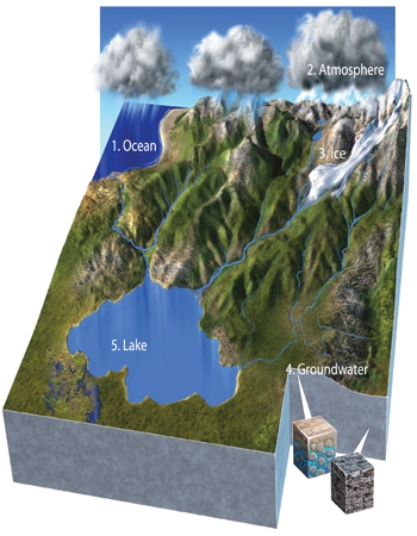
A) 1-ocean
B) 2-atmosphere
C) 3-glaciers and ice sheets
D) 4-groundwater
E) 5-lakes
Correct Answer

verified
Correct Answer
verified
Multiple Choice
How would this stream interact with groundwater? 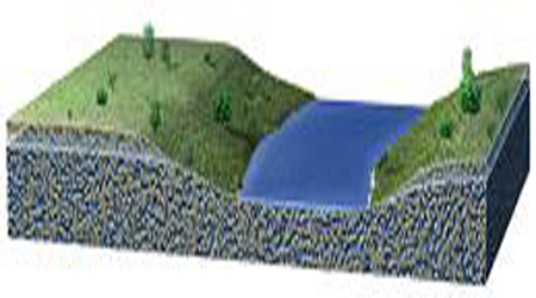
A) Groundwater would flow into the stream, adding water.
B) The stream would lose water as water in the stream flows sideways and up.
C) The groundwater and stream water would not interact.
D) The stream will only contain water if it is raining at that time.
Correct Answer

verified
Correct Answer
verified
Multiple Choice
Why does a plume of contamination spread out (become wider) away from the source of contamination? 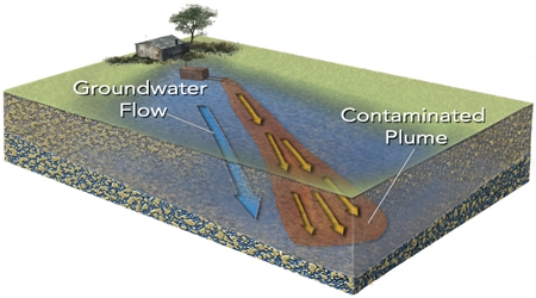
A) because the water flows faster and faster
B) because of diffusion of the contamination and mixing of contaminated and uncontaminated water
C) it does not spread out away from the source
D) it will only spread out if it is close to a cone of depression
Correct Answer

verified
Correct Answer
verified
Multiple Choice
Which of the following is a common setting for a spring?
A) a limestone aquifer that intersects the surface
B) a permeable upper layer with a water table deep below the surface
C) a nonpermeable upper layer with a water table deep below the surface
D) an unconfined aquifer with a water table deep below the surface
Correct Answer

verified
Correct Answer
verified
Multiple Choice
Most of Earth's fresh water is in
A) ice caps, glaciers, and groundwater.
B) groundwater and rivers.
C) lakes and swamps.
D) rivers and streams.
E) oceans.
Correct Answer

verified
Correct Answer
verified
Multiple Choice
Which of the following is a common setting for a spring?
A) the water table intersects the surface
B) a permeable rock overlies a less permeable one
C) sedimentary rocks overlie crystalline rocks along an unconformity
D) All of these.
E) None of these.
Correct Answer

verified
Correct Answer
verified
Multiple Choice
The short residence time of water in the atmosphere allows a water molecule to have a stronger ability to do which of the following, compared to a situation if the residence time in the atmosphere were larger?
A) acquire potential energy and convert it to kinetic energy
B) participate in the hydrologic cycle
C) erode the surface
D) store and release latent heat
E) All of these.
Correct Answer

verified
Correct Answer
verified
Multiple Choice
Which one of the following statements is true regarding the Earth's supply of fresh water?
A) The largest volume exists in lakes and reservoirs.
B) There is more in the form of water vapor in the atmosphere than there is as liquid groundwater.
C) There is more freshwater in glaciers and ice sheets than exists as groundwater.
D) There is more water in rivers than exists as soil moisture and groundwater.
Correct Answer

verified
Correct Answer
verified
Multiple Choice
Which of the following is NOT a possible source of water contamination?
A) dry cleaners
B) farms
C) rocks that have been mineralized by natural processes but not mined
D) houses
E) All of these are possible sources of contamination.
Correct Answer

verified
Correct Answer
verified
Multiple Choice
This map shows contours of the water table, the location of four factories (labeled A, B, C, and D) , and contaminated and uncontaminated wells.Which way will the contamination flow? 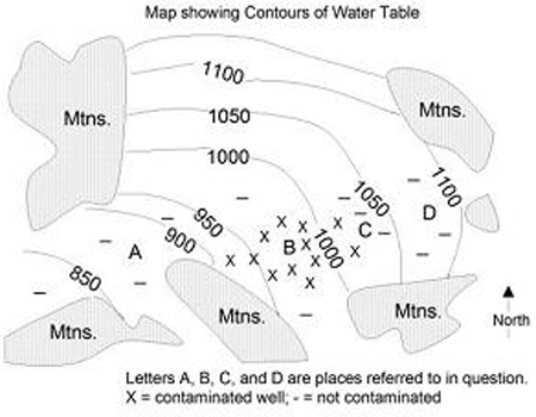
A) northeast, up the contours
B) southwest, down the contours
C) northwest and southeast, parallel to the contours
D) impossible to tell because the movement of contamination is independent of groundwater
Correct Answer

verified
Correct Answer
verified
Multiple Choice
Which of these numbered features contains the least amount of Earth's water? 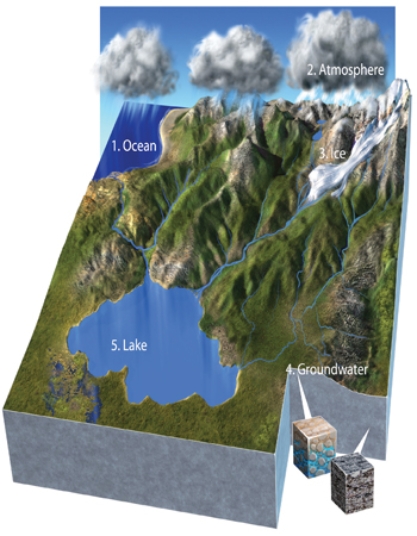
A) 1-ocean
B) 2-atmosphere
C) 3-glaciers and ice sheet
D) 4-groundwater
E) 5-lakes
Correct Answer

verified
Correct Answer
verified
Multiple Choice
This figure shows a new well that will pump out groundwater faster than it can be replaced.What will the water table look like after pumping? 
A) A
B) B
C) C
D) D
Correct Answer

verified
Correct Answer
verified
Multiple Choice
The water balance diagram below suggests that 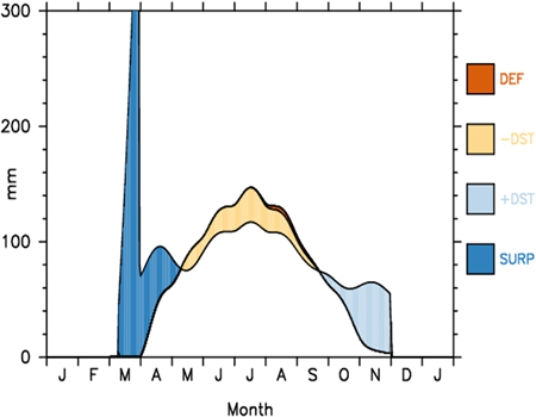
A) summers are very dry.
B) winters are snowy.
C) long periods of drought are common.
D) All of these.
Correct Answer

verified
Correct Answer
verified
Multiple Choice
Which of the following is true about the water table?
A) The water table has a similar shape to topography but is more subdued.
B) The water table is highest in elevation beneath lakes.
C) In any area, the water table slopes a consistent amount and direction.
D) All of these.
E) None of these.
Correct Answer

verified
Correct Answer
verified
Multiple Choice
Which of the following aquifers require a low permeability zone above it or below it?
A) artesian aquifer
B) perched aquifer
C) confined aquifer
D) All of these
Correct Answer

verified
Correct Answer
verified
Multiple Choice
According to this graph, which shows water balance for the Ogallala aquifer, which of the following statements are true? 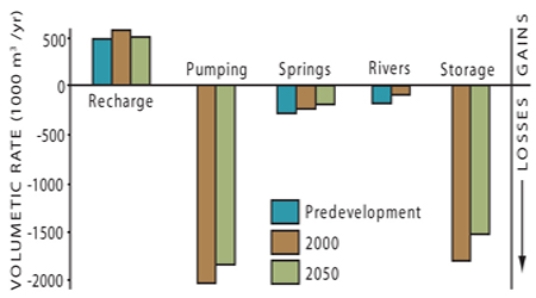
A) More water is taken out of the aquifer than is gained from recharge.
B) Less water is taken out of the aquifer than is gained from recharge.
C) Springs and rivers take out more water than does pumping.
D) As the aquifer dewaters, it expands, increasing the amount of pore space in which to store water.
Correct Answer

verified
Correct Answer
verified
Multiple Choice
Of the following, which has the greatest total volume of water?
A) the atmosphere
B) groundwater
C) ice caps and glaciers
D) rivers and lakes
Correct Answer

verified
Correct Answer
verified
Multiple Choice
Where on this cross section would water at the surface become groundwater? 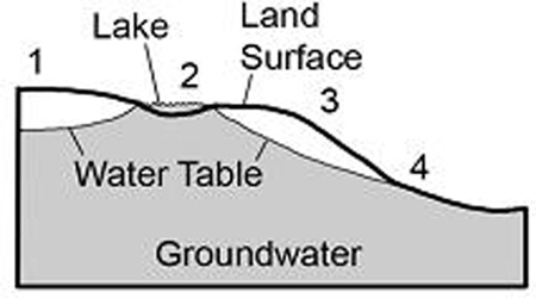
A) 1, 2, and 3
B) 1 and 3
C) 2 and 4
D) 2 only
E) 4 only
Correct Answer

verified
Correct Answer
verified
Multiple Choice
Which two uses consume most freshwater in the United States?
A) drinking water and showering
B) mining and raising livestock
C) irrigation and drinking water
D) mining and industrial use
E) irrigation and thermoelectric power
Correct Answer

verified
Correct Answer
verified
Showing 21 - 40 of 82
Related Exams